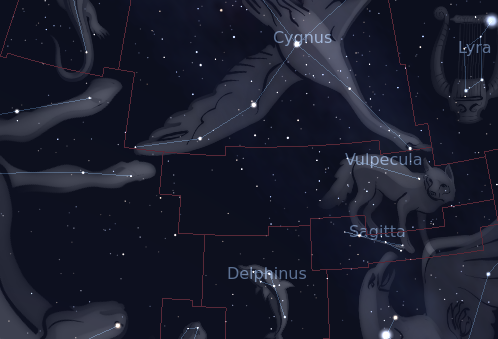The Constellation Vulpecula
Vulpecula is a small, faint constellation in the northern sky, introduced by the Polish astronomer Johannes Hevelius in 1687.
It can be found in the middle of the Summer Triangle asterism, and is highest in the evening sky in the months around July.
Vulpecula contains no bright stars &ndash Alpha Vulpeculae shines at a meagre mag 4.4. It does, however, lie close to the plane of the Milky Way, and contains several open clusters. The Dumbbell Nebula (M27) – the brightest planetary nebula in the sky – also lies within its borders.
Vulpecula represents a fox with a goose in its mouth, chosen by Hevelius because it lay next to two other hunting animals, the Eagle (Aquila) and the vulture (a historical interpretation of Lyra).
1687 (Hevelius)
0.7% of the sky
268.2 square degrees
Hover the pointer over the name of an object to highlight its position on the starchart to the right, or click to see more information.
| Stars | Open Clusters | Globular Clusters | Galaxies |
| α-Vul (mag 4.5) | NGC 6882 (mag 5.7) | NGC 7080 (mag 12.4) | |
| 23-Vul (mag 4.5) | NGC 6940 (mag 6.3) | NGC 7052 (mag 13.1) | |
| 31-Vul (mag 4.6) | NGC 6823 (mag 7.1) | NGC 6921 (mag 13.4) | |
| 13-Vul (mag 4.6) | NGC 6830 (mag 7.9) | ||
| NT Vul (mag 4.7) | NGC 6802 (mag 8.8) | ||
| QR Vul (mag 4.7) | IC 1299 (mag 14.0) | ||
| 1-Vul (mag 4.7) | NGC 6793 | ||
| 29-Vul (mag 4.8) | NGC 6800 | ||
| 12-Vul (mag 4.9) | NGC 6827 | ||
| 30-Vul (mag 4.9) | NGC 6904 | ||
| 9-Vul (mag 5.0) | NGC 6938 | ||
| 32-Vul (mag 5.0) | |||
| 28-Vul (mag 5.0) | |||
| 17-Vul (mag 5.0) | |||
| 4-Vul (mag 5.1) | |||
| QS Vul (mag 5.2) | |||
| 3-Vul (mag 5.2) | |||
| NU Vul (mag 5.2) | |||
| 33-Vul (mag 5.3) | |||
| 24-Vul (mag 5.3) | |||
| 35-Vul (mag 5.4) | |||
| ES Vul (mag 5.4) | |||
| 19-Vul (mag 5.5) | |||
| 10-Vul (mag 5.5) | |||
| 18-Vul (mag 5.5) | |||
| 25-Vul (mag 5.5) | |||
| HIP 97961 (mag 5.6) | |||
| 27-Vul (mag 5.6) | |||
| 5-Vul (mag 5.6) | |||
| HIP 97765 (mag 5.6) |




